This post is part of a draft on South Siberian language homelands and Sprachbünde.
The following text contains a description of Ob-Ugric languages and their connection within an Ugric Sprachbund. Special emphasis is placed on their evolution among surrounding ethnolinguistic groups before they were first documented, and on their most likely connection with archaeological cultures succeeding the Seima-Turbino phenomenon in the Southern Urals and the Trans-Urals. The archaeological-archaeogenetic discussion is therefore focused on the Middle Bronze Age Cherkaskul and Late Bronze Age Andronovo-like cultures, as well as on the formation of the “Scythian” Sargat cultural horizon of the Eastern Trans-Urals, due to their patrilineal connection to sampled modern Mansi and Khanty-speaking groups.
- Eastern Uralic
- Archaeology and Population Genomics
PLEASE NOTE. Many of the Y-SNP calls from ancient samples referred to below have been analyzed by the FamilyTreeDNA Haplotree team formed by phylogeneticist Michael Sager and Göran Runfeldt from the R&D team. Those ancient samples with validated haplogroup inferences are marked by a hyperlink to the FTDNA Haplotree. Occasionally, though, such hyperlinks are also used in the text when discussing Y-SNP branches in general, without referring to specific ancient samples. For a quick reference of ancient samples, you can check out the Ancient DNA Dataset, also visually in an Online Web Map, in SNP Tracker, or in AncientDNA.info. TMRCA and formation dates have been checked from YFull.
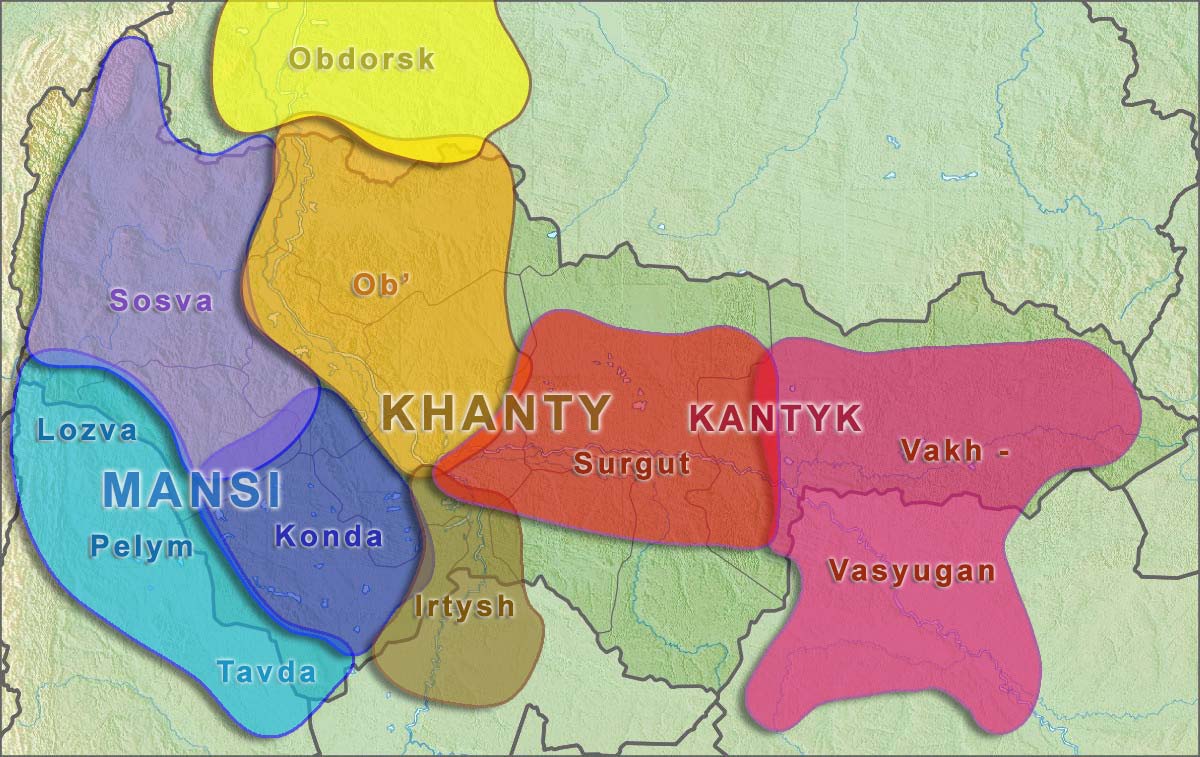
1. Eastern Uralic
In terms of lexical coincidences, PIE/Pre-PIIr./PIIr. borrowings as well as inherited PU words seem to have similar developments in Samoyed, Khanty, and Mansi. Attesting to a potentially short-lived period of loosely shared Ugric-Samoyed or Proto-East Uralic community is the presence of common phonetic innovations, such as (J. Häkkinen 2007:71-78; 2009: 13):
- Split *e̮ → *e,̮ *i̮ (the difference remains in Khanty and Samoyed).
- Merge *s, *š → *š.
- *š → *ʟ (→ Ms. *t ~ Kh. *ʟ ~ Smy. *t ~ Hu. Ø).
- *ś → *s (→ Ms. *s ~ Kh. *s ~ Smy. *s ~ Hu. s).
- *x, *w, *k → *γ (between vowels in i-stems).
- *ks, *sk → *γʟ or *kś, *śk → *γs (attenuation of *k:n in consonant clusters with sibilant or *t:n).
1.1. Ob-Ugric languages
There are about 150 common Ugric lexical innovations (Kulonen 2003, with refrence to Honti), such as vocabulary related to horses, cf. Hu. ló ~ Ms. low ~ Kh. loγ ‘horse’; or Hu. nyereg ~ Ms. näwrā, Kh. noγər ‘saddle’. There is no commonly accepted reconstruction for Proto-Ugric, and it is possible that the three branches formed a Sprachbund of intermediate proto-languages (Aikio 2020). The small number and irregular phonetic correspondences suggests a situation qualitatively different to the other known Uralic branches, but their other shared features (development of sibilants and common postpositions / case suffixes) support long-lasting intensive contacts.
Ob-Ugric languages, Khanty and Mansi, display over 400 common lexical innovations (Kulonen 1993, Sipos 2002). Of these, Sipos (2002) classified 208 as regular, without presenting phonematic correspondences. In fact, there is no commonly accepted reconstruction for Proto-Ob-Ugric, either, which makes many of those shared innovations impossible to assess reliably as inherited. In any case, a part of this wordstock probably reflects shared substrates or borrowings from Western Siberian (unattested?) languages (Saarikivi 2020: 11).
NOTE. In that respect, Ob-Ugric languages resemble Saami and Samoyed, which also show a distinct non-Uralic stratum related to the tundra, from unidentified sources.
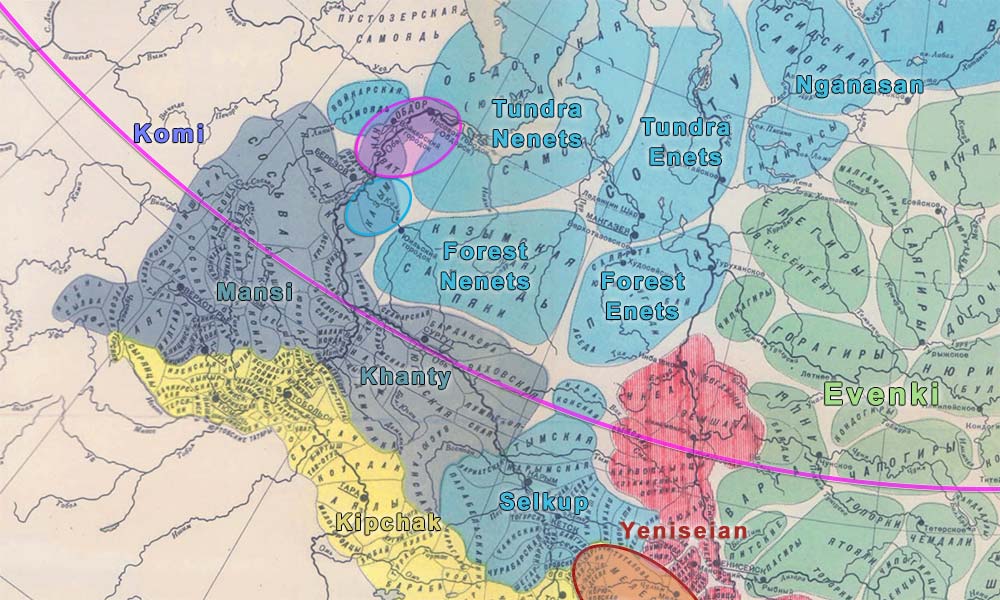
1.2. Areal linguistics
1.2.1. Indo-Iranian
Attesting to their early independent dialectal development, most Indo-Iranian borrowings show a separate adoption into Pre-Khanty and Pre-Mansi rather than as regular Ugric or Ob-Ugric loanwords. Even the often-cited PUg. *säptä ‘seven’ (← PIIr. *sapta-/ PIr. *safta-) only shows a regular output in PKh. *ʌǟpət, whereas PMs. *sǟtə could be interpreted as supporting that the change PUg. *s → *θ happened late and as parallel developments in the different branches, and the h- in Hu. hét might be a later borrowing or a result of analogy with hat ‘six’ (cf. Holopainen 239-240, with references).
The many Proto-(Indo-)Iranian borrowings found in Ob-Ugrian points to a notable diffusion of Indo-Iranian cultural innovations, especially from the Iranian-speaking world to the (Pre-)Ob-Ugrian peoples. Compare (Holpainen 2019, passim):
- POUg. *ēräɣ ‘song’ ←? PIr. *ā-garH ‘to greet, call’;
- POUg (?) *eträ (Zhivlov 2006: 108; Honti 1982: 73) ← ? Pre-Ob-Ugric/PU *iträ ‘clear sky’ ←? PIr. *wīdra/*idra- ‘clear’ → Oss. ird ‘bright, clean’;
- POUg. *mɔ̈ŋki ‘forest-spirit’ ← Iranian, compare Middle Persian mēnōg ‘spirit’ ← PIIr. *manyu-ka-;
- POUg *ńātV- ‘to help’ (Zhivlov 2006: 138) ← ? Iranian *nād-, cf. Av. nāidyah- ‘the weaker one’, OInd. nādh- ‘find oneself in need’;
- POUg. *päčäɣ ‘reindeer’ ← PIr. *patsuka- → Av. pasu- ‘livestock’, diminutive pasuka-; cf. OInd. pásu-, pāśuka- ← PIIr. *paćuka-.
Both Khanty and Mansi also show Iranian cultural loans which can be more specifically pinned to Alanic/”Pre-Ossetic” contacts, although it is impossible to attribute them all to only one particular chronological layer of “Scytho-Sarmatian” contacts. Compare (Holpainen 2019, passim):
- Kh. ʌi̮γər ‘armour jacket’ ← MIr. *zγar- (→ Ossetic zγar ‘armour’);
- Kh. pĕnt ‘path’ ← PIr. *pantH- (→ Avestan paθō, Sanskrit pánthā-, pathí-);
- PKh. *kǟrtV ‘iron’, possibly from Permic, cf. PWU *kürtńV (cf. PIIr. *kr̥tí- → OInd. kr̥tí- ‘dagger, knife’, and PIIr. *kártana- → OInd. kártana- ‘a cut’), but possibly related to the same source as PMs. *kīrV ‘knife’ (cf. PIr. kartá- → Av. karəta- ‘knife, dagger’);
- PMs. *širγV ‘sword’ ← Iranian (Alanic) *cirγ ‘sword’ → Ossetic cīrğ ‘sword’;
- PMs. *šǟrkVśV ‘eagle’ ←? Iranian (Alanic) *cargas, cf. Ossetic cærgæs ‘eagle’.
- PMs. *wī̮sәγ ‘calf’ ← Iranian *wasá- ‘calf’, compare Ossetic wæss ‘calf’;
- PMs. *ǟsVrVmV ‘shame’ ← Alanic *æfsærm → Oss æfsærm, æfsarm;
- PMs *pē̮ńtV ‘brother-in-law’; etc.
Similar Indo-Iranian and especially “Scytho-Sarmatian” or Alanic layers are also found in Pre- to Proto-Samoyedic, and in Pre- to Proto-Hungarian; for the latter, compare for example (Holopainen 2019, passim):
- PUg. ?**arV, cf. Kh.N. worti ‘younger brother of mother’, Kh.North å̄r, Ms.West oår ‘relative from mother’s side’, Hu. ara ‘bride; mother-in-law’; all three parallel borrowings from Middle Iranian/Pre-Ossetic *wra-/*awra- ‘brother’, cf. Ossetic ærwada, Pamir wrod, etc.;
- PUg. ?**kasiw ‘a type of fish’, cf. Hu. keszeg, PMs. *kǟsəŋ, PKh.? *küsə, likely parallel borrowings from Iranian (cf. Ossetic kasag ‘fish’) or all from the same third source;
- Hu. özvegy ‘widow(er)’ ← Alanic *widwæz, cf. Ossetic idæʣ(æ) (Milanova, Holopainen & Bradley 2018);
- Hu. *arwV ‘price’ ← Iranian, cf. Ossetic arγ, OInd. argʰá- ‘price’.
NOTE. Different Iranian loanwords are also found in Pre- and Proto-Permic on the Cis-Urals, with the Alanic layer likely stemming from intense contacts with Ananyino. Some dubious examples of this chronological layer might have reached up to Proto-Finnic.
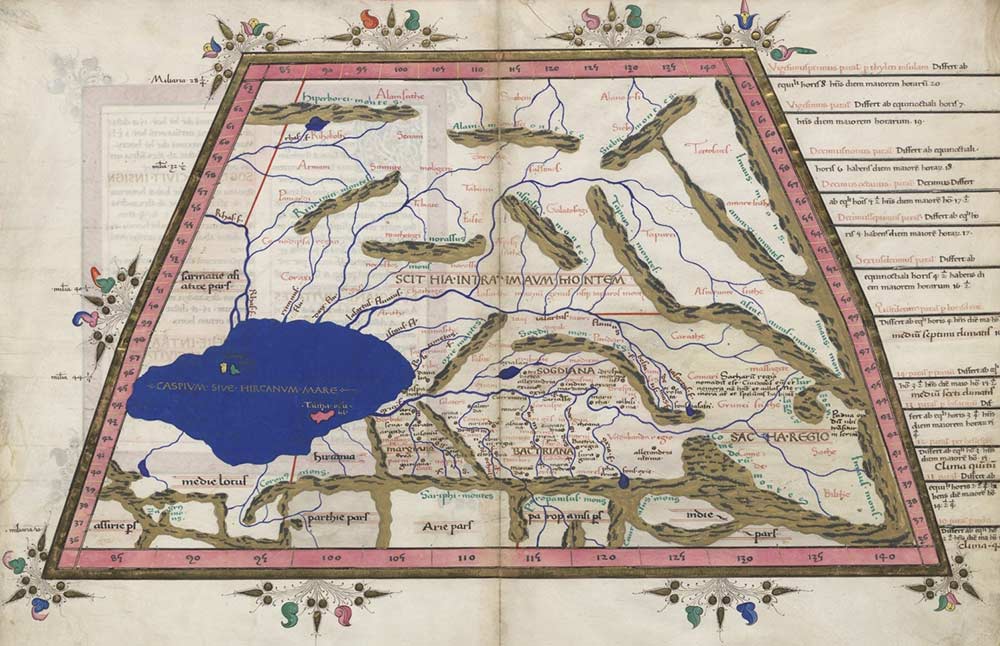
1.2.2. Turkic and Permic
Dybo (2014) sums up the loanwords in Turkic languages and borrowings from Turkic among Siberian languages (see below for Ob-Ugric loans in Proto-Turkic). Cultural loans from Proto-Turkic into Ob-Ugric include:
- POUg. *ūri̮ ‘suitable, skill’ ← PTk. (CTk.) *ūř ‘master’.
- POUg. *tarma ‘god’ ← PTk. *Taŋrï ‘god’?
- POUg. *wūjma ‘skein of wool’ ← PTk. *ojma ‘felt’.
- POUg. *pe̮rγa ‘pipe, piped stem’ ← PTk. *burgu ‘pipe, hunter’s call; piped stem’.
- (?) POUg. *pe̮kta ‘dung, excrements’← PTk. *bok ‘dirt, dung’.
- (?) POUg. *qe̮r-si̮ ‘without snow (about autumn)’← PTk. *Kiār-sïř ‘without snow’.
Some proposed Oghuric traits in Turkic loanwords found in Khanty might also be quite old (Savelyev 2013):
- PKh. *ćuḷći/*ćɨḷći ‘mouse’ ~ Chuvash šъrži ← PTk. *sɨčgan.
- PKh. *saart ‘pike’ ~ Chuvash śъ˘rttan ← PTk. *čortan.
- PKh. *jaaɣ ‘people, men’ ~ Chuvash jъ˘χ ‘kin, tribe’ ← PTk. **juk.
In Mansi, some isolated loanwords also exist; cf. Mansi (KU, KM, KO) pɔ̄̈ĺkǝnt, (So.) pāl’kat, etc. ‘small claw of cow, reindeer, deer’ ← PTk. *palga-n foot, sole, paw, palm’, with added Mansi suffixes -kǝnt and -kat. The Mansi form is usually related to PU *päl’kV ‘foot’ from a PMd. *päl’gä ‘foot’, although the actual reconstructible form, PMd. *pil’gǝ, seems less attractive as cognate. The word might have been borrowed from Pre-Evenki *palgan ← Proto-Tungus-Manchu *palga-n ‘foot; sole’. Other examples, possibly parallel borrowings from the same substrate word related to reindeer herding, include PMs. *poľkəs ‘boot’ and PMs. *paaľək ‘tail’.
NOTE. The known early contacts of Proto-Turkic with Proto-Samoyed places both of them in South Siberia during the 1st millennium BC (see below Proto-Samoyed Homeland and Proto-Turkic homeland), which probably establishes a terminus post quem for contacts between early Proto-Turkic dialects (including Pre-Oghuric) and an Ob-Ugric community from West Siberia.
The layer of numerous Siberian Tatar cultural borrowings seem to be part of later contacts (Savelyev 2013).
There are up to 400 Komi borrowings in Khanty (Toivonen 1956) related to animal husbandry, agriculture, housing, clothing, transport, high culture, etc. and about the same number in Mansi. Most of them reflect dialectal Komi features, and none show Proto-Permic or older characteristics, which connects them all to later (Iron Age or medieval) contacts (Saarikivi 2020: 61-62).
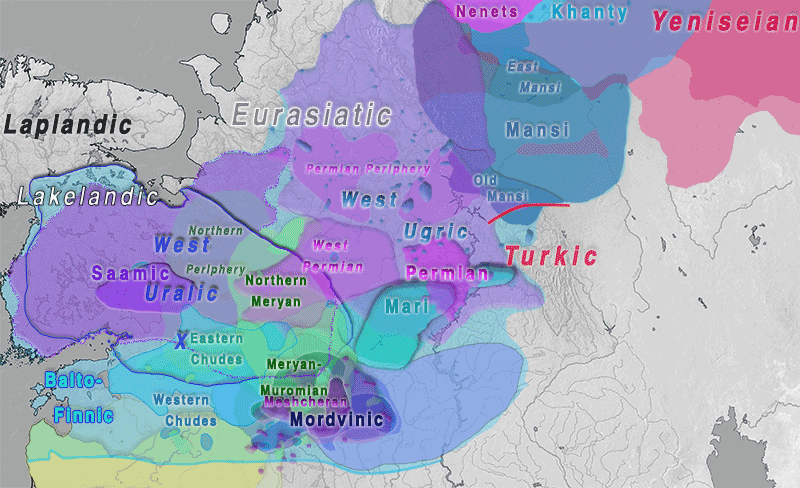
1.3. Historical accounts
The first accounts of Khanty and Mansi from Russian sources of the 15th and 16th century refer to rich and well-organized Yugra peoples having metal weapons with silver ornaments and fortified settlements, as well as wealthy chieftains whose position was based on fur trade, which contrasts with the more recent small and scattered hunter-gatherer and reindeer-herding groups.
Many features of Khanty mythology show a prominent role of the horse, attesting to their ancient linguistic homeland close to the steppes, contrasting with more recent myths incorporated from the circumpolar area, witnessing to the assimilation of northern populations. In fact, North Khanty displays a considerably simplified morphology and phonological innovations, with resemblances to North Mansi pointing to mutual contacts (Saarikivi 2020: 62-63).
The Khanty have accounts of warfare with Nenets, which the Mansi do not, suggesting that Proto-Khanty was also ancestrally located to the east within the Ob-Ugric community. The archaic features of East Khanty apparently indicate then an archaic periphery owing to an early spread, most likely from a south-western core, involving early encounters with Nenets, who had spread from the south-east no earlier than the first millennium BC (Saarikivi 2020: 62-63).
Many accounts of Mansis along the river Kama are recorded still in the 18th and 19th century, and – similar to Khanty – Mansi is suspected to have been spoken in a more south(west)ern territory than presently, having been assimilated by Tatars and Russians, whereas its eastern border was quite likely more stable (Saarikivi 2020: 65-66).
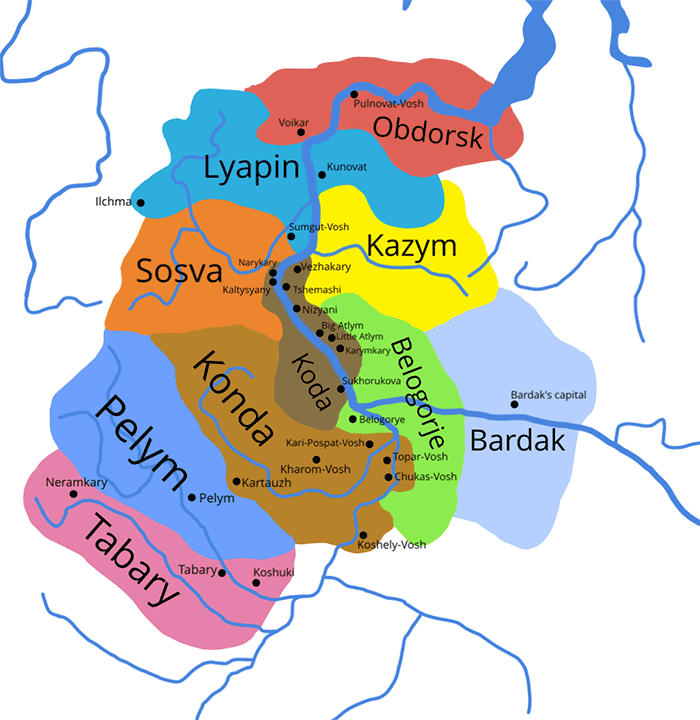
1.4. Hydrotoponymy
Within the East Khanty area, the Kazym region shows a toponymy reflecting a notable Forest Nenets substrate, suggesting their linguistic assimilation by the Khanty. In the Northern Khanty area, the Khanty replaced other languages, possibly including Samoyed groups, starting in medieval times, but details are unknown (Saarikivi 2020: 64).
A considerable body of Mansi toponymy exists in the Northern Urals without any noticeable substrate from other languages (Slinkina 2011), which indicates a relatively high age of Mansi habitation in the region (Saarikivi 2020: 67).
There are accounts of Mansi or or вогуличи (voguliči) west of the Urals, along the Pečora and Vychegda basins and the tributaries of the Kama, but they probably refer either to Mansi or an unattested West Ugric branch, not to Khanty. The Ugric toponymy west of the Urals (cf. Smirnov 2012) is probably related to those Ugric languages replaced by Permic.
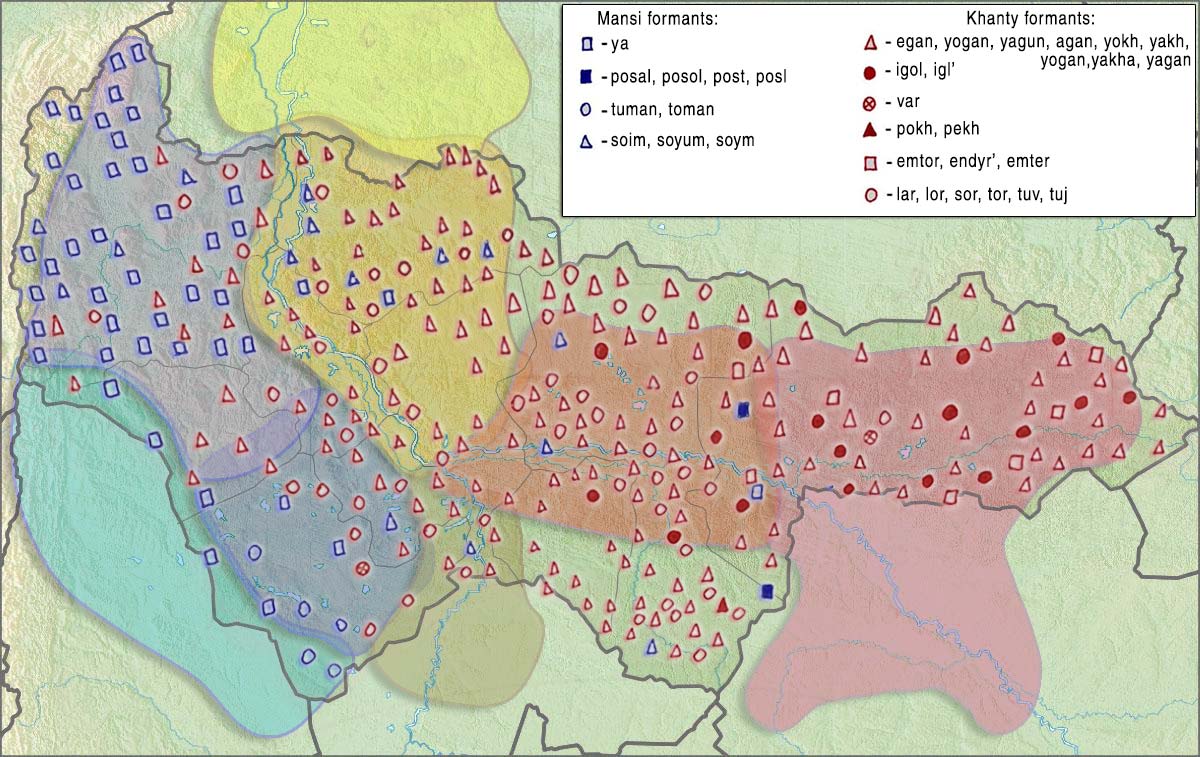
1.4.1. Yeniseic hydronymy
It is well known that Yeniseian-like hydrotoponymy extends far beyond the attested Common Yeniseian-speaking region of the early 17th century, around the Yenisei River Basin and Ob’-Yenisei interfluve, stretching as far west as the Irtysh River Basin and beyond. The presence of Yeniseian loanwords in East Khanty (Vajda 2020) further supports the survival of a Yeniseic-speaking population until very recently, as evidenced by hydronyms of the Ob–Irtysh watershed.
The etymology of the adopted ethnonym Pumpokol ← East Khanty *pum-poχǝl ‘grassy village’ (Georg 2007:18 after Anikin 2000: 458) offers more support to the ancient close contacts between both branches. Lacking any evidence for the presence of East Khanty close to the Chulym drainage basin, where Yeniseian (neighbouring Pumpokol) is known to have been spoken before the language shift to Chulym Turkic, it is very likely that both Selkup and East Khanty had interactions between each other and with the Pumpokol branch to the (north-)west, in the Ob’–Irtysh interfluve.
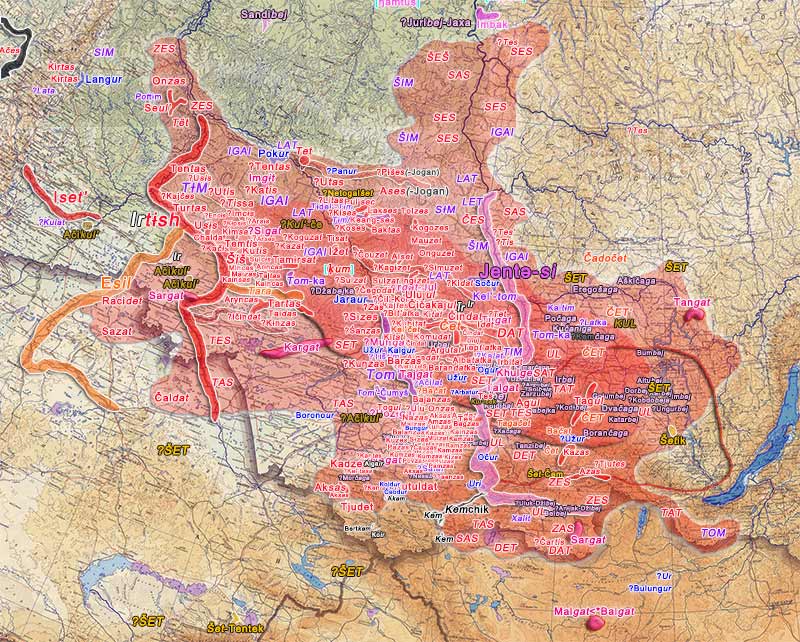
- Wider red area (more transparent) covers main Yeniseian hydronymy from Vajda (2020).
- Red elevated zone includes main Yeniseic hydronymy according to Maloletko (2000).
- Red border with shadowed rim: Core ancestral Cis-Baikal Common Yeniseian area according to Vajda (2019), between the Yenisei and Angara rivers.
- In red, sure Yeniseic hydronyms (with the basin of rivers or tributaries painted over in red, whenever possible). Dubious locations are marked with initial interrogation mark.
- In purple, likely Yeniseic formants without clear Yeniseian etymology.
- In magenta (with elevated painting over the water body), river or lake names of Yeniseic ethnonymic origin in gat/get, kat/ket.
- More questionable Yeniseic formants:
- In blue, names in ur.
- In brown, names in kul potentially spread by non-Yeniseic peoples.
- In orange, names in šet potentially spread by non-Yeniseic peoples.
- In fuchsia, formants in si/ši potentially related to Yeniseic, or to a preexisting Palaeo-Siberian substrate.
- In dark orange, possible Yeniseic water body formants (Blažek 2015).
- In pink, likely Sikhirtya (Sixirtja) hydronyms in -čaga, -bej.
- Within [brackets], ethnonyms based on foreign words (color on the outside represents linguistic group using it, font color represents original language group).
- In black, distribution of a common “Palaeo-Eurasiatic” hydronymic formant, kam-/kem-.
Main consequences of the widespread Yeniseic hydrotoponymic area for Siberian (and especially Uralic) ethnolinguistic prehistory are manifold. Among the most important ones:
- The presence of divergent “Yeniseic” formants – i.e. not fitting the known Common Yeniseian dialects – farther away from the Yenisei River Basin supports that this layer predates the expansion of Common Yeniseian, guesstimated around the early 1st millennium BC. Since there is no potential eastward cultural expansion associated with Yeniseic beyond the Ob’ River Basin after the spread of the Andronovo horizon, this layer (or layers) must belong to a previous cultural expansion, like that of Okunevo-like cultures (see above Proto-Yeniseian Homeland).
- Neither Proto-Ob-Ugric nor Proto-Mansi or Proto-Khanty show an obvious Yeniseic substrate, unlike Proto-Samoyed (see below Proto-Samoyed Homeland). Based on the likely extension of Yeniseian-related languages throughout the whole Ob’–Irtysh system during the Bronze Age, it is very likely that the core pre- to proto-language homelands of Mansi, Khanty, and indeed Hungarian developed to the south-west of the westernmost Yeniseic hydronymic area, in close contact with the Southern Urals and steppe Indo-Iranians. Different loanword layers suggest their continuous presence in the forest-steppes from the Proto-Indo-Iranian stage to Old Iranian, including tight contacts with Middle Iranian-speaking nomads during the Scytho-Sarmatian period.
- The lack of a sizeable corpus of (Indo-)Iranian-related hydrotoponymy in South Siberia, despite the long-lasting presence of the Andronovo-like horizon and related groups during the whole Bronze Age – also partially continuing in the Iron Age – renders the ad hoc proposal of an unattested “Andronovo Aryan” (cf. Helimski 1997) untenable, on top of being unnecessary (cf. Holopainen 2019, passim), as is any proposal of long-lasting presence of Iranian speakers outside of the steppes and bordering forest-steppes. Of note, the Russian term for the Ob’ river derives from Iranian *ā́b- ‘water’ (cf. Pers. āb, Tajik ob, Pashto obə), which bears witness to the presence of East Iranians upstream before the arrival of Turkic, because different terms were used downstream by Samoyed and Khanty speakers to refer to the river.
- The overtaking of Forest Nenets and Selkup territory by expanding Khanty – most likely during the Middle Ages – and the guesstimated expansion of Proto-Samoyed during the 1st millennium BC attests to the survival of Yeniseic-speaking populations in the taiga after the spread of Cherkaskul materials and emergence of the Andronovo-like horizon throughout the forest-steppes. The lack of noticeable Indo-Iranian, Ob-Ugrian, or (ancient, Pre- to Proto-)Samoyed influence on Common Yeniseian further supports that Uralic dialects, like Indo-European ones, were the recent incomers from the south (-west and -east), and that Common Yeniseian spread over layers of Yeniseic or other unknown Siberian languages.
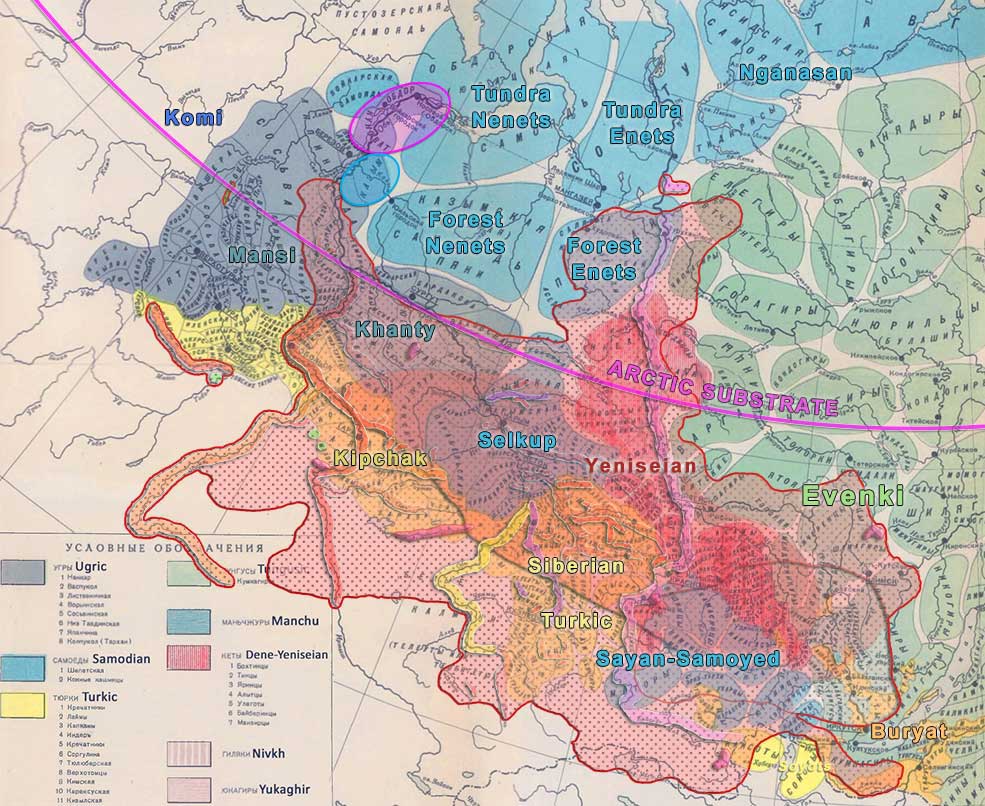
1.4.2. “Siberian” hydronymy
Furthermore, the unknown Siberian substrates found especially widespread in Saami, Ob-Ugric and Samoyed show a tight correlation with the lack of a recognizable ancient layer of Uralic hydrotoponymy in the Eurasian tundra and taiga biomes.
In fact, “Palaeo-Eurasiatic” (viz. Palaeo-European, Palaeo-Siberian, Palaeo-Arctic) formants are distributed in ancient regions where Uralic is assumed to have arrived more recently. For example, Matveev (1971) notices the lack of use as determinant in North-Eastern Europe of the formant behind Finland’s Kemi, Kumi; Northern Russian Kem, K’yama, Kyma, Kyama, Kama; Karelian Kem’; the same formant is possibly also behind the isolated Tuvinian Kem-. This use probably attests to its ‘foreign’ nature, originating in non-agglutinative languages. Their distribution conspicuously delimits in Europe what all other Uralic hydronyms reflect as the most likely core (earliest) Uralic hydrotoponymic area, to the west of the Kama River (see image below).
NOTE. Despite the traditional association of the Cis-Kama region as a point of origin of Yeniseian (cf. Maloletko 2000: 111-153), possibly due to a preferred Nostratic origin in the Caucasus in Soviet literature, the attribution of certain Common Yeniseian formants outside of the core area remains highly hypothetical: e.g. those in -(k)ul, -ur of isolated hydronyms (or hydronymic clusters) of North-Eastern Europe – e.g. up to the Oka river basin in Akulov & Efimova (2019); or those with a first formant in Šet- from Kazakhstan (Blažek 2015: 76), and indeed those river and place names without common formants for which a Yeniseian etymology is given. These have probably more plausible (Turkic, Uralic) etymologies that would be more reasonably associated with recent regional developments. Even if the association of the Seima-Turbino phenomenon with the expansion of Yeniseic renders all these comparisons a priori possible, they must be subject to the time frame of the earliest reliable hydrotoponymic layer of each region – given by its attribution to a specific archaeological culture.
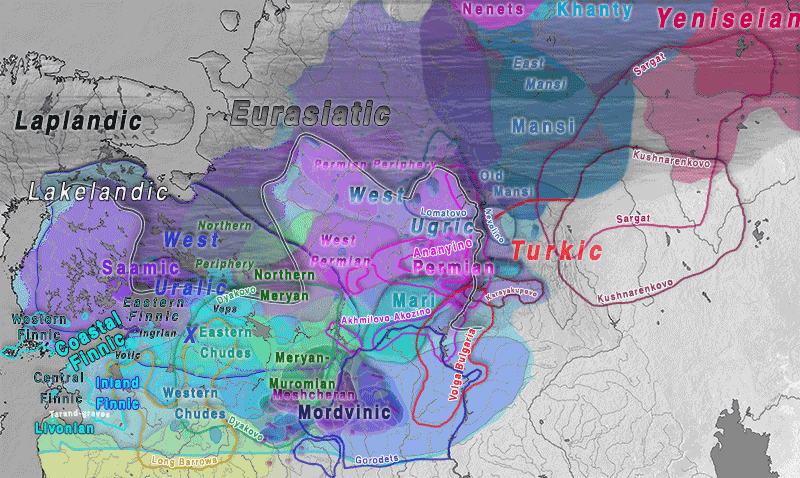
2. Archaeology & Population genomics
For the discussion below, a minimum knowledge of linguistic and archaeological evolution of Proto-Indo-Iranian is necessary. The early split and common European Agricultural Substrate found in North-West Indo-European and Paleo-Balkan languages contrasts with the later Asian Agricultural Substrate found in Proto-Indo-Iranian (with a likely origin in BMAC or related Central Asian agriculturalist groups), supporting the continuity of reconstructed main Late Proto-Indo-European subsistence economy, semi-nomadic pastoralism, into Proto-Indo-Iranian – agreeing with the picture found in the earliest Indo-Iranian texts (cf. Kümmel 2017).
It is therefore clear that the Proto-Indo-Iranian culture and language derives directly from Poltavka steppe herders, as supported by the cultural and (partial) genetic continuity found still in the Sintashta-Potapovka-Filatovka period, at the turn of the 3rd-2nd millennium BC, despite their evident centuries-long admixture with an Abashevo-related population in the formation of their chiefdom-based settlement system. This heavy interaction is also reflected in the Uralic substrate behind PIIr., as opposed to Pre-PIIr., and is correlative to the strong lexical influence of (Pre-)PIIr. on PU dialects (read more about this in the Proto-Uralic Homeland series).
The heavy influence of the early Agricultural Substrate found in Proto-Uralic, on the other hand, cannot point to anything other than Corded Ware groups from Eastern Europe, the first sub-Neolithic group to practice slash-and-burn agriculture in the region. The disappearance of this small vocabulary set to the east of the Urals is justified by the lack of agriculture in the region until much later. All that has become quite certain by combining findings of linguistics and archaeology with population genomics in the recent years.
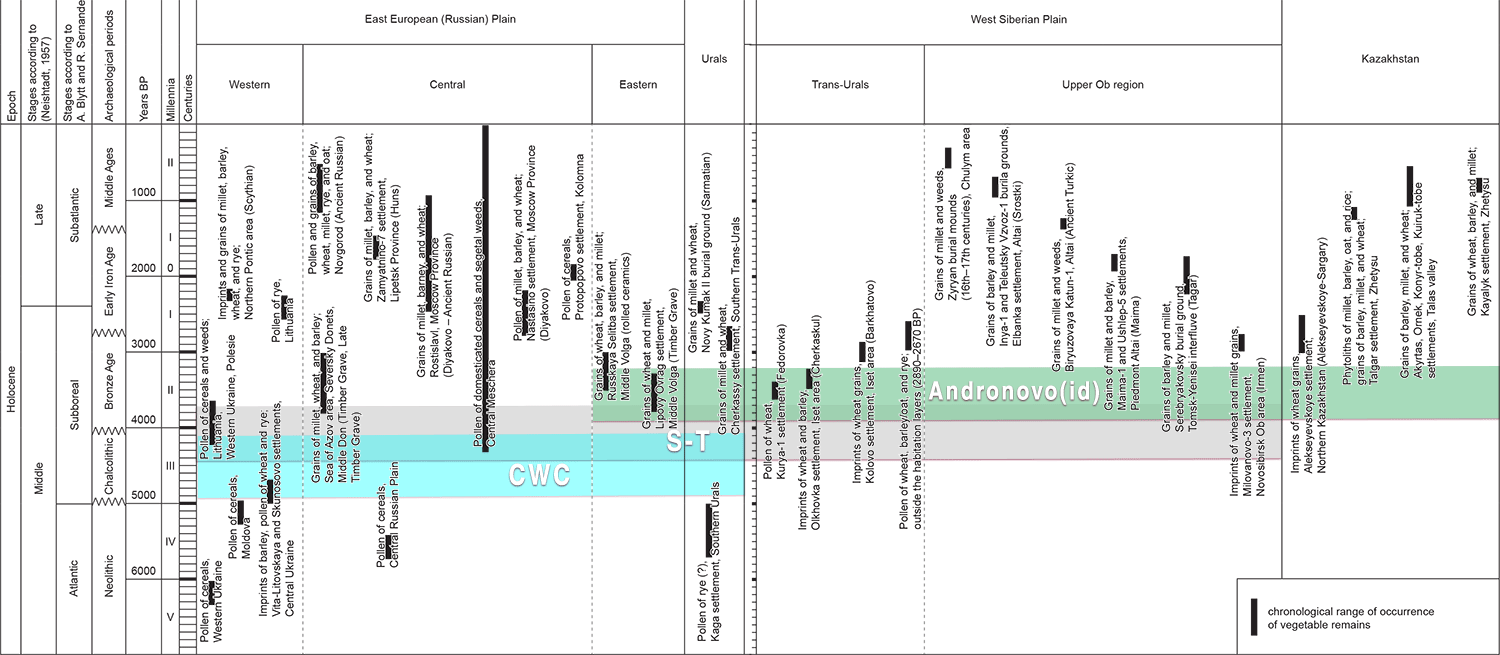
2.1. Seima-Turbino phenomenon
The origin and spread of the Seima-Turbino transcultural phenomenon or intercultural trading network is still a hotly debated question, probably for all the wrong reasons. The proposal of a purely eastern origin of the materials, and the closely related assumption of westward population movements involving Uralic speakers, has deep roots in early (Soviet) archaeological assessments, based among other data on the shape of the hollow-headed axes – as opposed to the socketed axes proper of the Andronovo culture – nearly round in the eastern region and nearly rectangular in the western region. Since the earlier hollow-headed axes found in Garino Bor also had a round socket, the rectangular shape was assumed by Chernykh to be later (cf. Chernykh & Kuzminykh 1989).
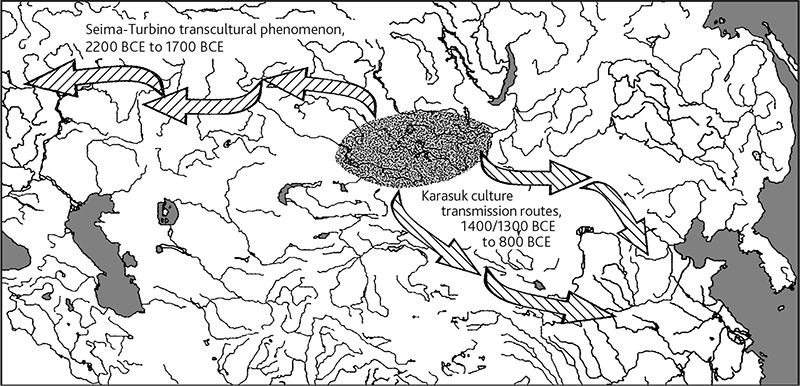
The opposing view of an Eastern European origin is based on the spread of specialized metalworking technology, with experienced Abashevo-related metallurgy displaying tin-bronze alloys and mastering of lost-wax casting (for decorative figures on dagger handles) and thin-walled hollow-mould casting (for socketed spears and hollow axes), contrasting with the primitive local Okunevo and Afanasevo metallurgy of the Sayan–Altai area that is proper of eastern Seima-Turbino materials. New types of spearheads and the casting of socketed spearheads as one piece around a blank and the traditional use of local animals also suggest an eastward spread of the technology (Carpelan and Parpola 2001o).
Even more compelling is the sequence of radiocarbon dates, which has been recently corrected to a much earlier period than previously assumed by the Soviets, with the whole complex now considered to have lasted from the 22nd century BC to the 18th or 17th century BC, which means that all cultures from Finland to East Asia belonging to this transcultural phenomenon were roughly coeval: Fatyanovo–Balanovo, Abashevo, Sintashta–Petrovka, Taskovo–Loginovo (on the Middle and Lower Tobol and Middle Irtysh), Samus (on the Upper Ob), Krotovo (forest-steppe of the Middle Irtysh to the Baraba steppe on the Upper Ob), Elunino, and Okunevo.
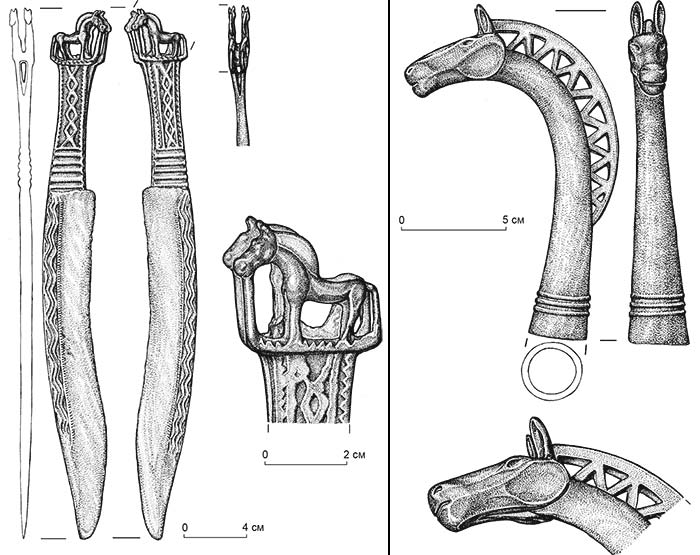
In fact, arsenic copper is found in materials of Seima-Turbino tradition from Abashevo and Fatyanovo-Balanovo cemeteries, where Russian archaeologists have often found multiple parallel “eastern” features, similar to Siberian and Trans-Urals cultures (cf. Chernykh 2004, pp. 25–30; Hanks et al. 2007; Chernykh and Kuzmineh 2010, pp. 251–268; Koryakova & Epimakhov 2014).
NOTE. Digging themselves deeper into an apparent circle of confirmation biases of previously wrong assessments, some research groups have recently tried to keep supporting that the ‘earliest’ Seima-Turbino radiocarbon dates come from the east, citing either (1) specific sites, as in in Chernykh, Korokhkova, Orlovskaya (2017), where the focus is on some isolated radiocarbon dates – with evident wide confidence intervals – such as Tartas-1 (ca. 2836-2144 calBC) or Sopka-2/4V (ca. 2466-2036 calBC), Sopka-2/4B (ca. 2334-2062 calBC); or from a general “east vs. west” point of view, as in Marchenko et al. (2017).
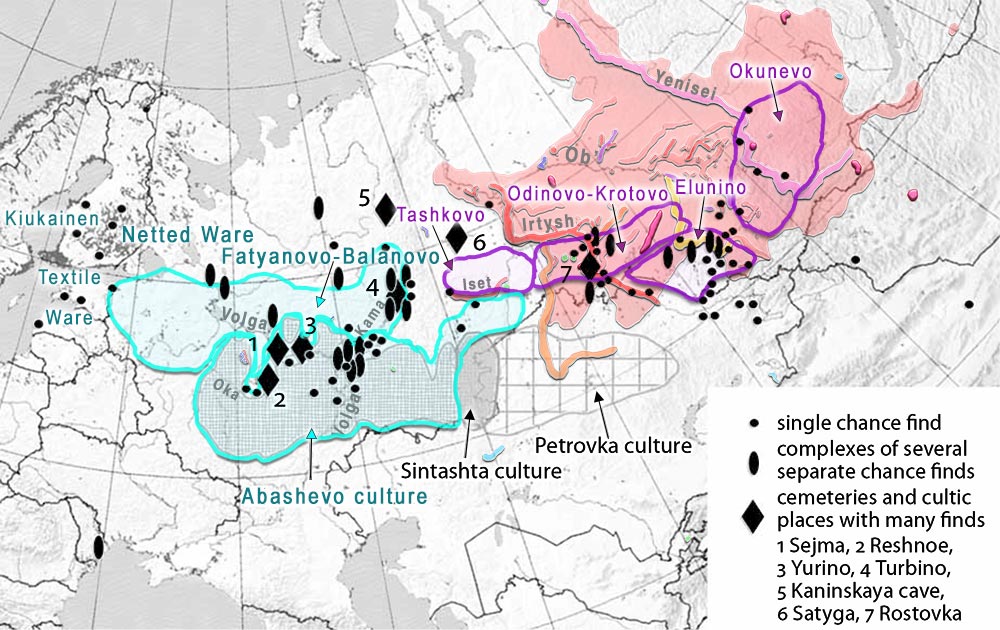
2.2. Andronovo-like horizon
The pre-Taiga Andronovo-like cultural horizon or “Andronovoid” complex of cultures is formed by Cherkaskul materials (Zamaraevo and Mezhovka around the Urals, and pre-Karasuk groups in the east), Pakhomovo, Suzgun, and Chernoozerïe. These have been traditionally considered bearers of Uralic languages. Andronovo ceramics of the Fëdorovo type, with metal objects specific to the Andronovo-Fëdorovo metallurgy of eastern Kazakhstan and Semirech’e, are decorated with images of animals found in the mountain-steppe regions of the Tian-Shan and Altai, which have long suggested that they were Uralic-speaking groups and forebearers of the Andronovoid complex (cf. Chernetsov 1948: 139, Ivanov 1963: 161, Kosarev 1974: 149-151, Veresh 1978; Potemkina 1983).
Alternatively, the Fëdorovo population has been considered to represent Indo-Iranian tribes under the strong influence of their northern Seima-Turbino-related neighbours in the formation of the productive economy, horse-breeding and metallurgy on the southern taiga (cf. Kuz’mina 1994; 2007: 199-204, with references), and as such would represent early interactions between Eastern Uralic and Proto-(Indo-)Iranian. The finding of isolated Abashevo-related (as opposed to Sintashta-related) materials up to the Zeravshan valley linked to the later appearance of Cherkaskul sites, as well as the noticeable influence of BMAC on early Uralic dialects supports the common development of early (Eastern) Uralic dialects and Proto-Indo-Iranian.
While no samples have been published close to the turn of the 3rd millennium BC, many later samples show a clear pattern of similar population replacement in the Andronovo-like horizon, traditionally considered the immediate forest Uralic neighbours of steppe Indo-Iranians. Therefore, whatever the actual impact of the Seima-Turbino complex might have been in terms of population change in Western Siberia, the succeeding “Andronovoid” phase in Seima-Turbino areas clearly supports the previous expansion of Abashevo-related ancestry and R1a-rich populations with Cherkaskul, and possibly also (at least in part) with Fëdorovo.
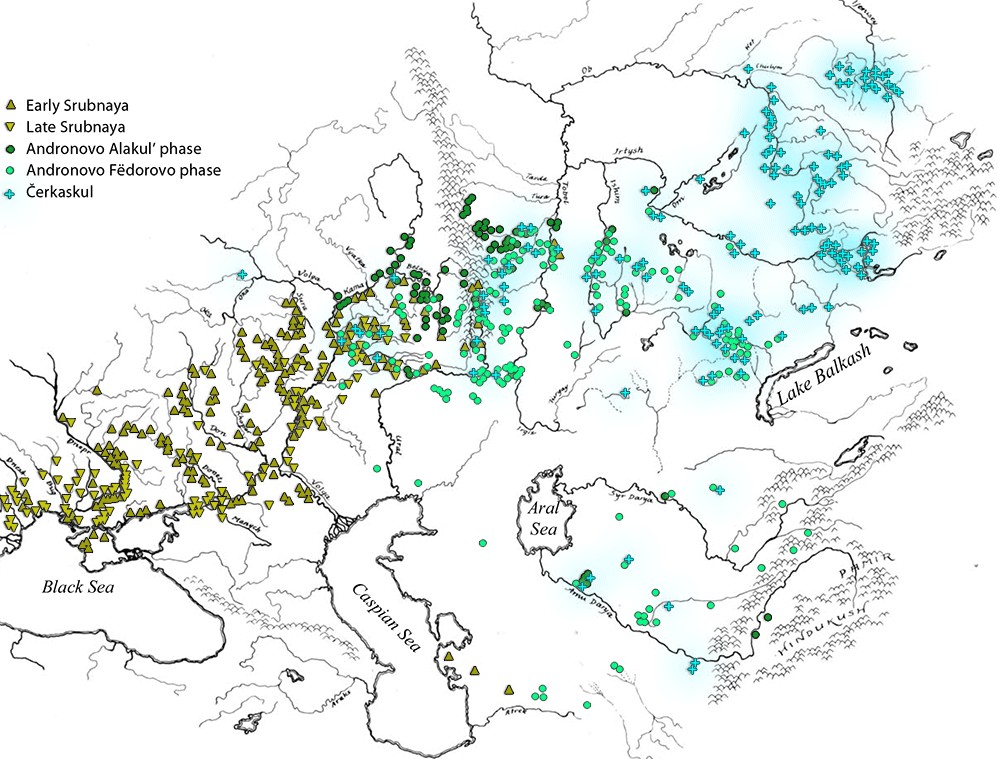
The Ob-Irtysh Baraba forest-steppe site Preobrazhenka-3 is a 2nd millennium settlement complex represented first by Krotovo materials, and then by Andronovo-related ones, succeeded by the Irmen culture. Materials from the Andronovo phase are correlated with Ob-Ugrian ornamental patterns and mythological meanings, as one of the traditional basis for their simplistic identification as early Ob-Ugric peoples in archaeology (e.g. Kovtun & Neskorov 2015). The bear-related cult is continued from pre-Krotovo sites to the kurgans of the Andronovo period (cf. Kovalevskij 2004, Nesterov 2018). This is the only Seima-Turbino-related site with genome-wide results published to date:
- The earliest sampled individual is female I6048, from Kurgan 6 (ca. 1729-1563 calBC), showing full Western Steppe_MLBA (Corded Ware-like) ancestry, belonging to the Seima-Turbino and/or Fëdorovo-Cherkaskul period.
- A 350 years younger Steppe_LBA male I6047 (ca. 1384-1213 calBC), of hg. R1a-Z93, probably belongs to the Irmen culture, showing continuity between the earlier Seima-Turbino-related sites and the later Andronovoid groups in genome-wide as in Y-chromosome haplogroups.
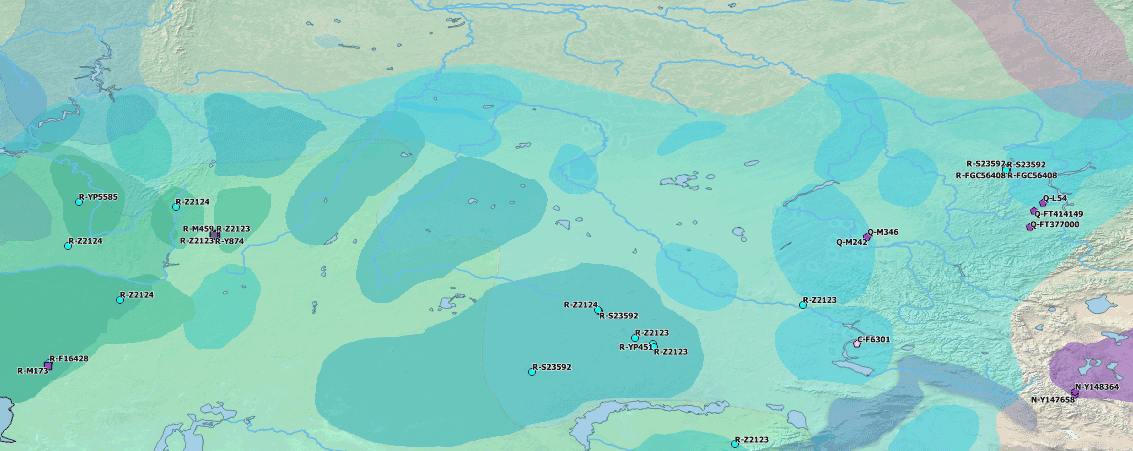
Closer to the Urals, continuity with the “Western” Cherkaskul territory is shown by the Andronovoid Mezhovskaya culture (ca. 1300-800 BC). Samples from the Kapova Cave (ca. 1431-1403 calBC in RISE523, the only radiocarbon-dated sample) show hg. R1a-PF6162/Z645(xZ283) and hg. R1b-M269 in two male samples, both from a Western Steppe_MLBA cluster but marked by an increasing admixture with likely local populations. This admixture is not seen in the female, a finding that can be interpreted (in light of similar patterns in Europe) as female exogamy with a predominant tradition of patrilocality.
The presence of R1b-M269 in the most likely ancient representative of an Ugric-speaking population supports the known close interactions with ancient Indo-Iranians from the western steppes, including the adoption of (Pre-)PIIr. loanwords in Uralic for family ties and trade.
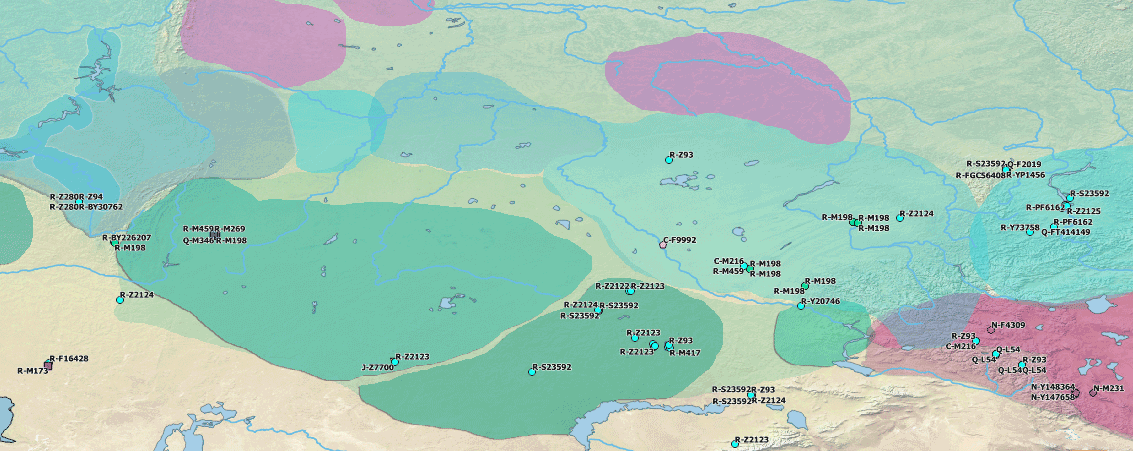
Interestingly, there is no discernible single pattern of local admixture among samples from assumed Andronovo-like groups, supporting that the Abashevo-related “Western Steppe MLBA” ancestry found in Srubnaya-Andronovo and Andronovo-like cultural horizons is mostly indistinguishable (see online data visualizer from Narasimhan et al. 2019), and that Y-DNA bottlenecks offer the most relevant data to follow early Uralic vs. Indo-Iranian expansions. In that sense, the spread of some specific R1a-Z280 (see ancient map of R-Z280 until IA and timeline slideshow) and R1a-Z93 lineages (see ancient map of R-Z93 until IA and timeline slideshow) found from north-west to north-east Eurasia seems to be associated with a late wave of Corded Ware-related migrations that did not undergo Indo-Iranization in its eastern group through their admixture with Poltavka steppe herders.
This, in turn, is corroborated by the lack of migration or admixture events during the whole Eastern European Bronze Age on the other end of the earlier Seima-Turbino network, among populations developing Textile Ceramics and Netted Ware groups from Battle Axe, Fatyanovo-Balanovo, and Abashevo influences (see more e.g. on published samples from Estonia LBA/IA and Fatyanovo). R1a-PF6162/Z645-rich Bronze Age populations from the South-Eastern Baltic to Southern Siberia are thus evident direct offshoots of late-3rd millennium Corded Ware cultures continuing undisturbed until the Iron Age, with a geographical and chronological origin of the modern R1a-Z280 and R1a-Z93 star-like phylogeny in Eastern Europe loosely corresponding to the traditionally described Late Proto-Uralic homeland in the Oka–Volga–Kama region.
Together with the findings related to Seima-Turbino, all this indirectly supports the initial simplistic assessments by Soviet anthropologists of cultural parallels between recent Uralic-speaking populations and Fëdorovo-Cherkaskul groups – hence of widespread Uralic–Indo-Iranian interaction evidenced by Fëdorovo materials – and seems absolutely incompatible with any alternative proposal, such as a widespread and long-term acculturation of Indo-Iranians all over the northern ‘Andronoid’ frontier, unless their presence is impossible to see in substratal-induced language change or hydronymy, which runs counter to evidence of such hypothesized long-lasting and widedpread linguistic presence elsewhere in the world.
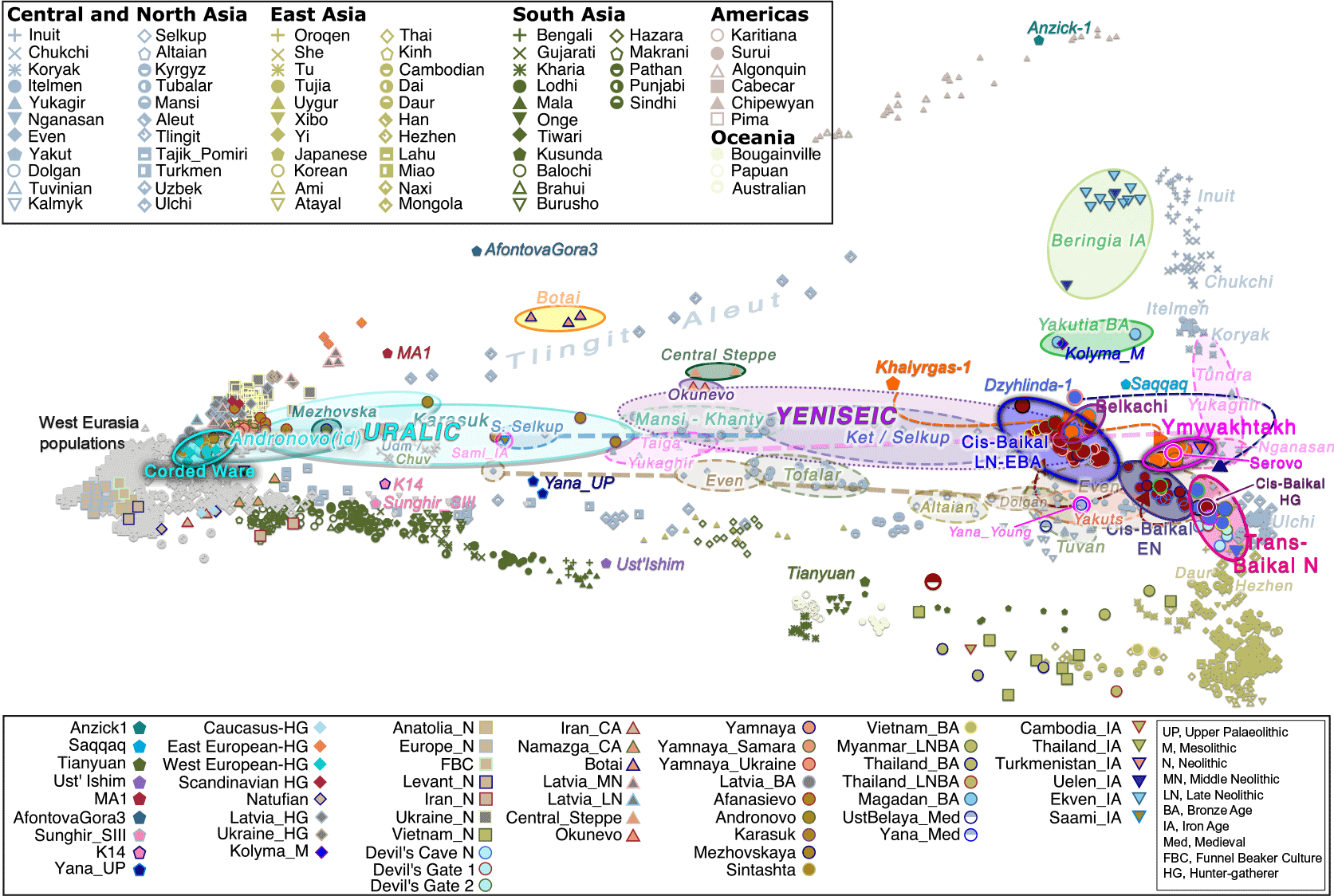
2.3. Sargat culture
Different complex population movements and cultural changes are described during the transition of the Late Bronze Age to the Iron Age. In the west, Gamayun’s pottery suggests incoming influences from Atlym in the Lower Ob’, whereas Itkul’ emerges as main metallurgical center of the Trans-Urals, with both continuing (and expanding) the previous Mezhovskaya territory in close contact with the Ananyino and Akhmylovo cultures, the metallurgical centers of the western Urals (Koryakova and Epimakhov 2007).
Populations from the LBA-IA transition and EIA show a trend toward increasingly fortified settlements compared to the previous period, most likely due to the pressure of peoples from the steppes, the nomadic Saka and later Sauro-Sarmatian populations that ranged north and south seasonally and penetrated the Trans-Uralian areas (Hanks 2003).
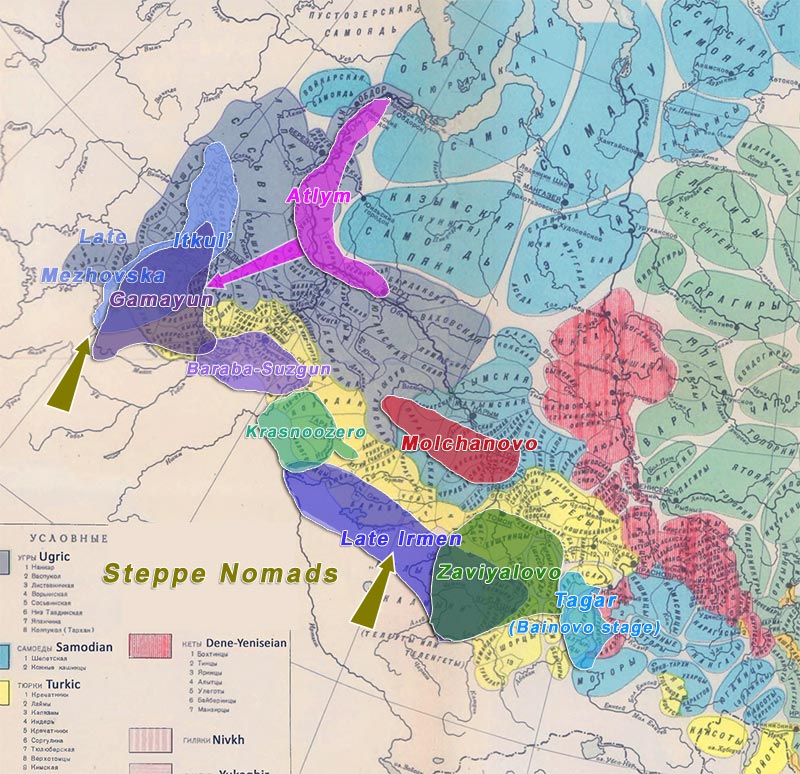
Itkul’ groups like Nosilovo, Vorobievo, Zelenomys neighbored the incipient Gorokhovo and (the post-Suzgun-Barkhatovo) Baitovo cultures. Both were eventually replaced by the Sargat horizon under incoming elites from the east. The Baraba-Suzgun pottery shows regional continuity with pre-taiga and taiga zones of the Irtysh basin, whereas Late Irmen shows influence from the Berlik culture, formed by incomers from Kazakhstan. Based on the example of Chicha-1, Berlik immigrants appear to have formed first a symbiosis similar to Abashevo and Poltavka in the formation of Sintashta-Potapovka, but in this case the Late Irmen locals represented the fortified elites, whereas Berlik incomers inhabited the surrounding areas (Molodin et al. 2008).
The Eastern Trans-Urals developed thus under an important period of contact with nomadic populations incoming from the east and south. The resulting post-Irmen type is assumed to be the germ from which the Sargat culture emerged. The Sargat culture is therefore traditionally interpreted as an eastward-spreading population of originally Iranian-speaking “Scythian” elites dominating over Ugric-speaking locals.
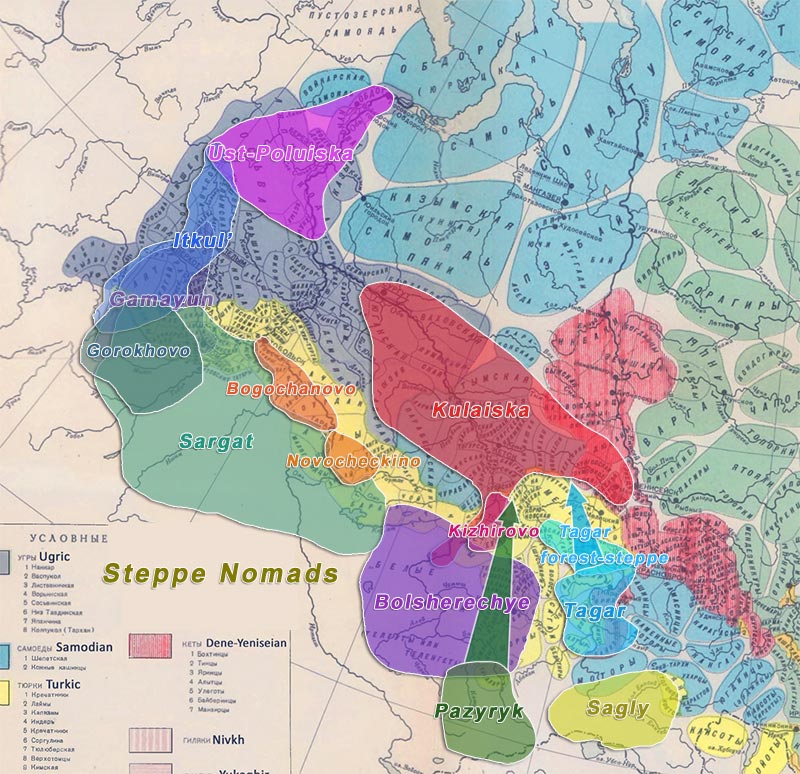
Findings from the recent Gnecchi-Ruscone et al. (2021) appear to support the hypothesized intrusion of steppe nomads forming the Sargat elites. Sampled individuals display a roughly homogeneous ancestry similar to other Iron Age “Scythian” cultures, like Tasmola and Pazyryk samples, with a minimum contribution from another “North-East Asian” source. That minimal contribution could be expected to happen in the north based on previous samples like Preobrazhenka and subsequent LBA contacts with taiga populations, as much as a “BMAC” source was expected in the south, but could also represent a different eastern origin of these nomads closer to Lake Baikal.
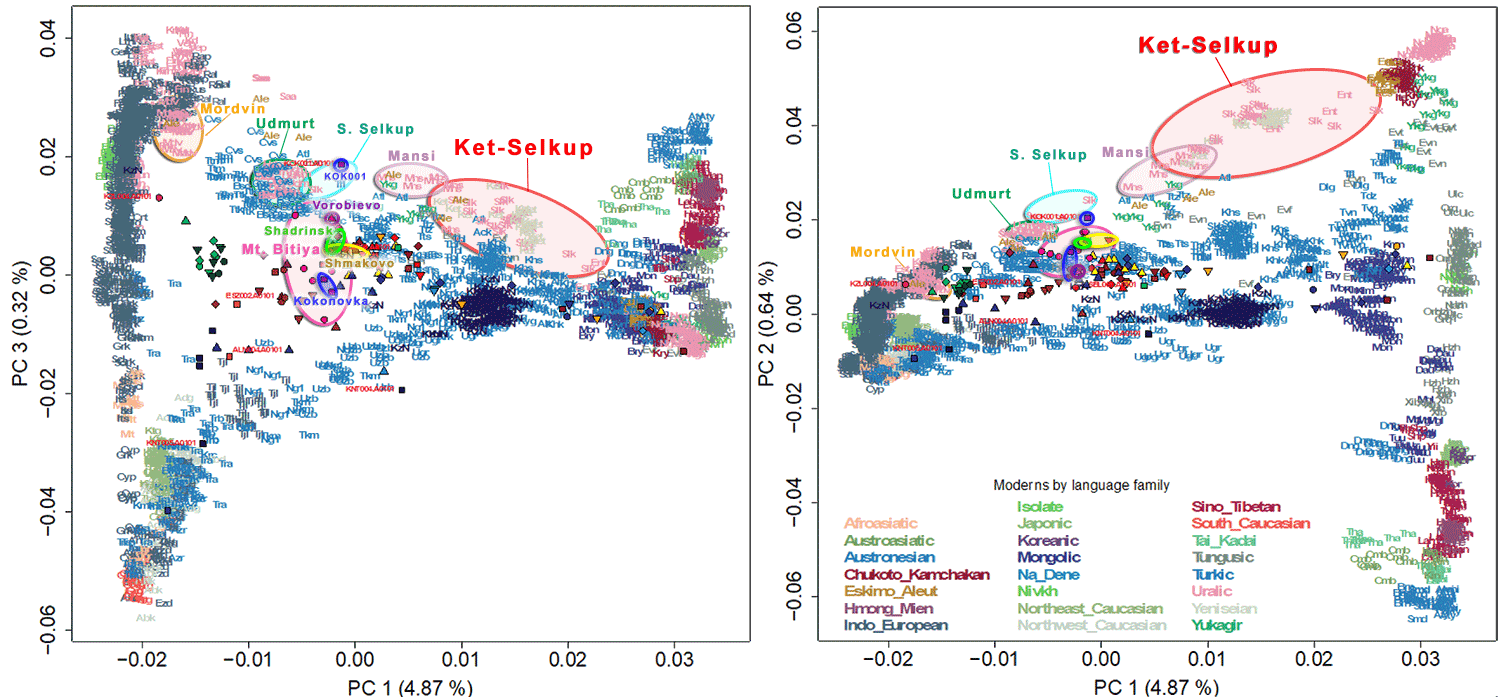
What was probably not expected was the appearance of the high variability of hg. N among nomads also on the Eastern Trans-Urals this late, despite the already evident late link between hg. N-CTS2929 in North-Eastern Europe and the (Pre-)Scythian LBA/IA expansions, inferred from the appearance of other N-Y6058 lineages among Avars, Turks, and Mongols. After all, haplogroup N-Z1936 was supposed to have spread through the Arctic and Hypoarctic region, infiltrating Uralic-speaking cultures from the tundra on both sides of the Urals with Bronze Age admixture events, not with Iranian- and Turkic-speaking nomads…
These are the haplogroups found in Sargat, most belonging to the Sargat phase, after the semi-nomadic chiefdom-based Gorokhovo had been gradually absorbed (ca. 4rd-3rd c. BC):
- Basal Q1b-YP3953 is found in the westernmost and earliest sampled (Gorokhovo-Sargat stage?) Shadrinsk group, and slightly later in the Sargat stage Mount Bitiya group. It is conceivable that the other (tentatively assigned) Q1 from Mount Bitiya belongs to this same subclade, but it could also expand the range of Q1 subclades associated with Sargat elites. This specific subclade is found in a coeval Tasmola sample from Kazakhstan, which supports that even these early Gorokhovo western lineages spread with nomads, despite the Shadrinsk group clustering to the north in the PCA, close to the modern “Neo-Siberian” cline of Eastern Uralic peoples. The same branch Q-YP4010 is associated with Cis-Baikal Neolithic/EBA populations, and some of its subclades are probably directly linked to earlier Dene-Yeniseian and Yeniseic expansions (see map of ancient Q-YP4010 and timeline slideshow).
- R1a-Y56 is found in a sample from the second-earliest site (based on radiocarbon dates), Shmakovo, and upstream hg. R1a-Z93 is also found in a later sample from Bogdanovka, as well as in three previously published Y-STR-predicted samples from the Baraba and Cis-Tobol Tyumen forest-steppes. The specific subclade found in Sargat is not attested elsewhere in ancient DNA, but its sister clade R1a-Y52 (TMRCA ca. 1300 BC) is found spreading with Sarmatians, Xiongnu, and medieval Turkic samples, pointing to a forest-steppe/taiga (and possibly eastern) origin of the parent hg. R1a-FGC4547 (see map of ancient R-FGC4547 and timeline slideshow).
- R1b-M269 in Mt. Bitiya. Other roughly coeval R1b-M269 samples are found in a Tasmola culture individual (ca. 300 BC), in a Sarmatian from Pokrovka (ca. 300 BC), and in a Late Sarmatian from the Ural-Aral region (ca. 230 BC). Despite the ‘western’ pattern of known R1b-M269 samples during the LBA-IA, it is very likely that Sintashta-Potapovka- and Afanasievo-related lineages survived in the east, and are the origin of these Iron Age steppe lineages. See map of LBA-IA R-M269 and timeline slideshow).
- N(xN1,xN2-FT324) is found in a sample from Mount Bitiya, which makes it a likely N2-MF52704. Haplogroup N2 is associated with Cis-Baikal and Eurasian steppe cultures since the Neolithic, and is found spreading with “Pre-Scythian” and “Scythian” groups from Central Mongolia to Hungary (see map of ancient N2-B482 and timeline slideshow).
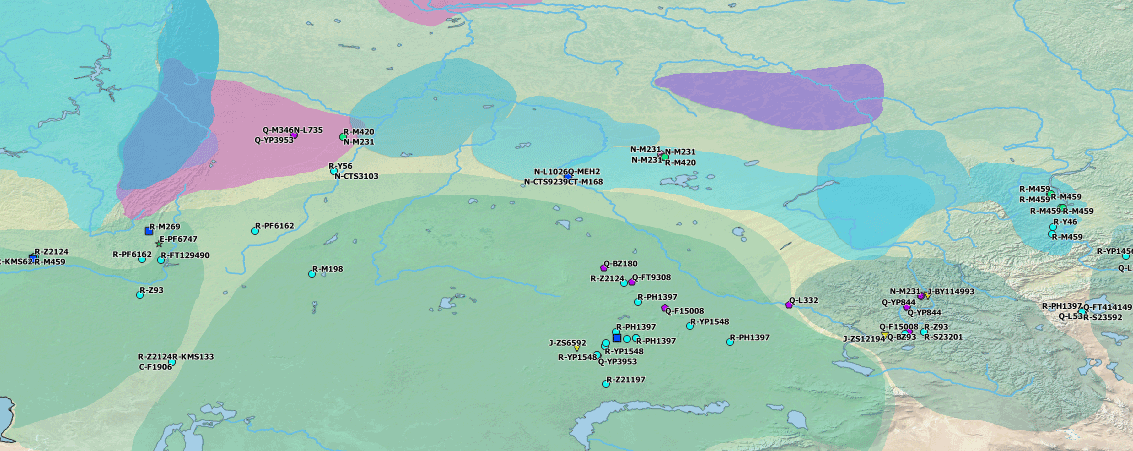
- N-Tat is found in Shmakovo (1), Vorobievo (1), and Mount Bitiya (7), as well as in the later Bogdanovka (1), apart from six previously published Y-STR-predicted N-Z1936 (N-Z1934??) from the Baraba and Cis-Tobol Tyumen forest-steppes (see map of pre-medieval ancient N1a-Tat and post-medieval, and timeline slideshow).
- Bogdanovka is the latest site from sampled Sargat, but shows paradoxically a potentially basal N-L839(xB211, xL1026), probably due to its easternmost location within the culture’s territory.
- A possibly basal N-CTS9239(xCTS6967) is found in Mt. Bitiya.
- Two possibly basal N-CTS3103 are found in Shmakovo and in Mt. Bitiya.
- Three N-Z1936 are found in Mt. Bitiya, and FTDNA reports that all three belong to N-BY199053, an ‘archaic’ subclade of the same N-Y13851 branch later found bottlenecked (under downstream N-Y13852>Y13850>L1034) among the medieval Uyelgi, as well as in modern Turkic and Ugric populations on both sides of the Urals (see map of ancient N-Z1936 and timeline slideshow).
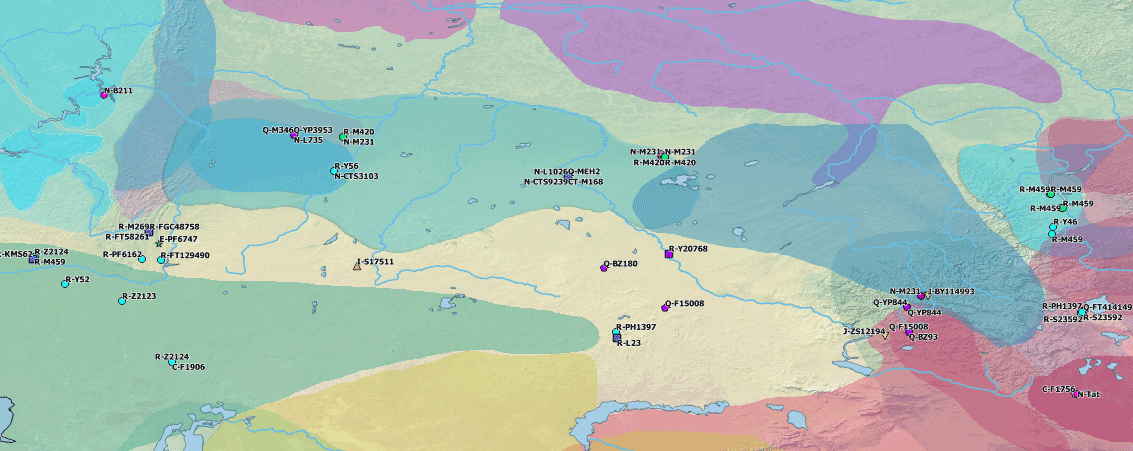
Recent evolution and hg. N-Z1936
The split of Pre-Hungarian, Pre-Ob-Ugric (or Pre-Mansi and Pre-Khanty) ca. 2000 BC or earlier and the likely Sprachbund formed after their split is clearly represented by Abashevo-related migrants evolving first as the ‘western’ MBA Cherkaskul groups. Their geographical separation from Pre-Samoyed developments after the Seima-Turbino phenomenon means a likely location of the group on the western end of the Andronovoid horizon, since Pre-Proto-Samoyed is quite evidently associated with ‘eastern’ Cherkaskul groups evolving into the LBA Karasuk culture, and Proto-Samoyed probably spread with the Iron Age Tagar culture (see below Proto-Samoyed Homeland).
Judging by the lack of similar genetic profiles in the most likely ancestral homeland of Ugric populations along the Urals–Irtysh forest-steppes, the ancestry of modern Ob-Ugrians represents acculturated non-Uralic-speaking tundra populations (read more on Palaeo-Arctic and Palae-Siberian clines). Similarly, the prevalent patrilineal bottlenecks among modern Ob-Ugrians are without a doubt the result of recent developments, but at least surviving Y-DNA haplogroups are informative of more ancient connections. From Tambets et al. (2018) and Post et al. (2019), both using and updating reports from Ilumäe et al. (2016):
- Modern Mansis show ca. 60% of hg. N1a(xTat) – a majority of them being N-B523/P43 – and ca. 16% hg. N-Tat – a vast majority of them being N-L1034. The latter is double in Konda Mansis (ca. 30%) compared to Northern Mansis (ca. 15%), where N-B523 increases proportionally. There is a lesser proportion of ‘(forest-)steppe’ haplogroups like R1a (ca. 8%) and R1b (ca. 4%).
- Modern Khants show ca. 31% N1a(xTat), most if not all N-B523, and ca. 50% of hg. N1a-Tat, with more than half of them N-B211, and the rest mostly N-L1034. Other haplogroups include R1b (ca. 11%) and R1a (ca. 6%).
- The amount of basal N-Z1936* is stable in both populations at ca. 3%, a proportion only paralleled in Komis, suggesting an expansion along the Urals (now more likely from south to north).

Judging from the data offered by historical linguistics, including areal contacts and hydronymy, the most obvious (but still tentative) ancestral association with archaeological cultures is that of the (Gamayun &) Itkul’ culture with the spread of Proto-Mansi (Parpola 2012). This is supported in genetics by the presence of N-B523, an ‘archaic’ non-Tat subclade that seems a priori more likely to have spread westward through the tundra, and that is consequently found increasing from south to north. The relative higher proportion found among Mansis relative to Khants is thus compatible with their assumed long-lasting presence in the Northern Urals, and acculturation events among indigenous populations are further supported by the Siberian substrate found in Ob-Ugric.
The Proto-Khanty community might have been more restricted to a southern territory in the Eastern Trans-Urals, taking into account the more recent relative chronology of Khanty hydronymy. Parpola’s (2012) suggestion of their earlier association with late Andronovoid groups like Nosilovo, Baitovo, Late Irmen, or Krasnoozero before their absorption by the Sargat horizon is supported by an increase in “nomadic” (forest-)steppe haplogroups in Modern Khants relative to Mansis, such as N-Z1936 (and probably N-B211), R1b, and R1a, among others, despite sharing approximately the same latitude as surviving Mansi groups in historical times.
The shared Mansi-Khanty Y-DNA bottlenecks, stemming from Late Iron Age and medieval expansions, is probably the end result of a process that started with the establishment of chiefdoms in the Sargat cultural horizon under eastern “Scythian” elites.
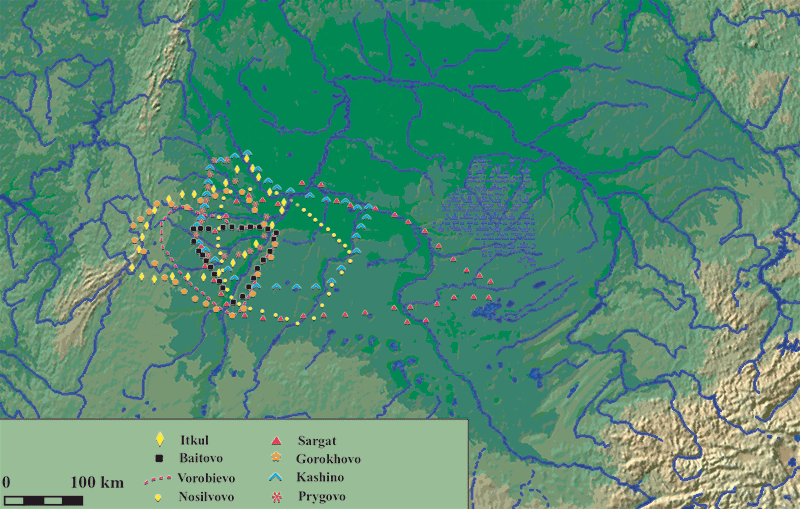
Ural region (map prepared based on information from Sharapova 2000). Image modified from Hanks (2003).
The Proto-Hungarian homeland is traditionally located on (or close to) the steppes based on palaeolinguistics, assuming a more south-western location within the late Ugric Sprachbund. Parpola’s (2012) idea that the Proto-Hungarian community corresponds to the Western Trans-Uralian pastoralist Vorobyevo and Gorokhovo cultures – before they became part of the Sargat horizon – is compatible with the isolation from Ob-Ugric innovations and with the common developments shared with Proto-Mansi. On the other hand, it needs to assume that the Sprachbund convergence with Permic can be chronologically ascribed to later contacts of Karayakupovo with the Volga-Kama area, and that intense contacts with Mordvinic are even later. Support for a more western location (in the Cis-Urals) is found in the widespread hydronymic area left by an unattested West Ugric branch in the Cis-Urals, and in the presence of North-East European R1a-CTS1211 lineages among Early Hungarian elites (see ancient map of R-Z280 until the Iron Age and timeline slideshow).
The westward expansion of the Sargat horizon with (semi-)nomadic elites displaying lineages with a likely Eastern Steppe origin, coupled with the attested multilingual nature of other Iron Age and medieval tribal confederations displaying similar hierarchical settlement patterns (such as the Xiongnu or succeeding Huns), supports that the core eastern Sargat intercommunity emerged as an amalgamation of Middle Iranian-speaking (Saka) elites – but possibly also Pre-Proto-Oghuric (see below Proto-Turkic Homeland) – over the previous ‘local’ LBA groups derived from the Andronovoid horizon (Parpola 2012). If (at least) both Proto-Hungarian and Proto-Khanty could be pinned to western and eastern groups integrated in the same loose forest-steppe “Scythian” horizon, their uninterrupted independent development since their split 2,000 years prior would support that different Uralic languages spoken by the majority of the Sargat population survived under the newly established forest-steppe and taiga chiefdoms, with the language of the elites becoming a likely lingua franca of the whole cultural horizon, and representing the Alanic adstrate on Ugric languages (see above).
The location of Proto-Hungarian remains nevertheless disputable based on linguistic evidence. Sargat-related N-Z1936 lineages are later found bottlenecked under a very specific subclade in Late Kushnarenkovo and Early Hungarian Conquerors. This patrilineal connection could confirm the hypothesized continued (or renewed) contacts between Khanty- and Mansi-speaking areas in the east, and between the Mansi- and Hungarian-speaking areas in the west, despite their linguistic – and likely also geographical – separation since the Early Bronze Age. To complicate things, however, the medieval Uyelgi show a cline stemming recently from Saka-like ancestry (similar to Turkic groups), as well as a predominantly Turkic N-PH573 subclade, at a time when Turkic peoples were already found widespread throughout the Eurasian steppes and forest-steppes (read more on the Proto-Hungarian Homeland).
NOTE. The traditional simplistic association of Ob-Ugric peoples with hunter-gatherers is unlikely to represent ancient Ob-Ugrians, as stated above, and even less so ancient Uralic-speaking peoples (see Proto-Uralic Homeland). The continued relevance of horse-riding material culture among Ugric peoples is supported by the inheritance of related vocabulary since the earliest Ugric community, and the continued intense language contacts with Indo-Iranian, Iranian, and Turkic steppe (agro)pastoralists seems incompatible with northern Siberian hunter-gatherer groups.
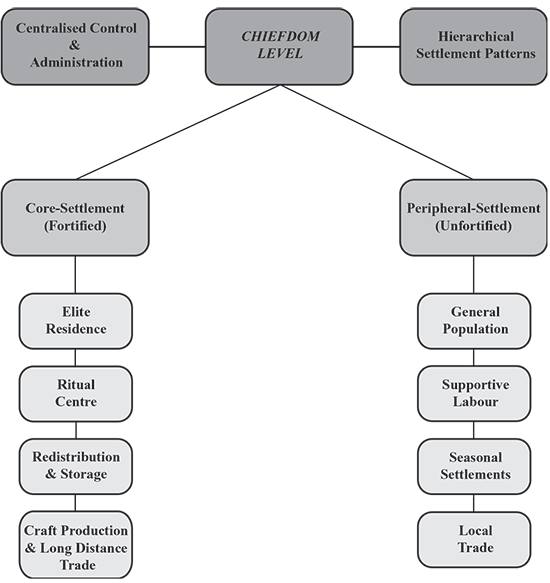
It is not fully clear yet how the different N1a-L729 subclades spread to their ancient and current distribution (see modern N-Tat distribution maps). The likely EBA spread of basal branches through the tundra with Ymyyakhtakh, as well as the later independent and recent spread of different N-Y6058 and N-Z1936 lineages with “Pre-Scythian” and “Scythian” nomads expanding from the east was unexpected, when inferences were made based solely on the distribution among modern populations (see here for my 2018 predictions). This begs the question: how and when did N-CTS9925/Z1934 spread through the north, reaching its westernmost (Finns and Estonians) and easternmost (Nganasans) presence among Uralic speakers?
For the moment, we know that sampled Late Iron Age and early medieval SW Finns show fully Corded Ware-like ancestry and are very likely to have undergone a marked Y-DNA bottleneck under hg. N-CTS2929/VL29, a common South-Eastern Baltic Late Iron Age haplogroup, as expected based on the origin of the Finnic expansions around the Gulf of Finland. The first FTDNA reported N-CTS9925 subclade, N-Y33117, is found in an Early Modern Finn (PD28) from the Porvoo Dome. This is compatible with a late admixture of Early Finns (and Saami) with Eastern Fennoscandian populations during the Late Iron Age / Early Middle Ages, possibly marked first in available samples by the arrival of “Siberian” ancestry in Late Iron Age Levänluhta.
A possible explanation of the modern distribution pattern of this haplogroup, then, deduced from these basal N1a-Tat samples and dubious (Y-STR-based) “N-CTS9925/Z1934” in forest-steppe sites of the Sargat horizon, is that their expansion was associated with reindeer pastoralists of the Iron Age/Early Middle Ages, since these highly mobile groups could have spread quickly and undergone the necessary acculturation events from an original area in the northern Urals. That is, if we have to discard an ancient spread of these N-L1026 subclades through the tundra (with Palaeo-Laplandic-related populations) and accept a more recent LBA/EIA or later appearance in Europe.
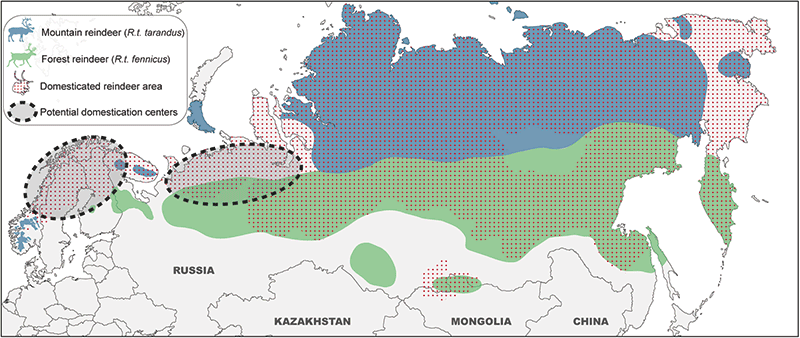
(a, after Kardash and Girchenko 2018; Reindeer Herding 2019) and of the two reindeer subspecies, including wild and domestic populations in Eurasia (b, after CAFF 2001), with localization of their potential domestication centres according to Røed et al. (2008). Image modified from Pelletier et al. (2020). The common word for (domestic) reindeer is an Eurasian Wanderwort stemming ultimately from Proto-Iranian *pacu- ‘cattle; livestock’ (see Proto-Uralic Animal Husbandry), which might connect the intermediate Iranian source with an adoption from a “(Pre-)Scythian” community.